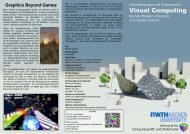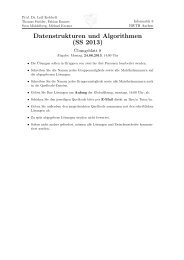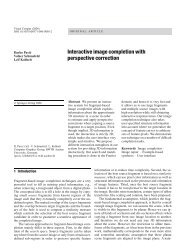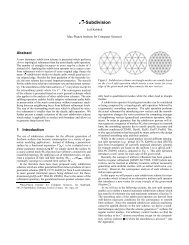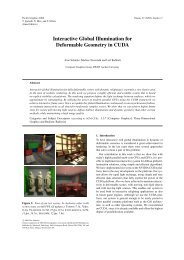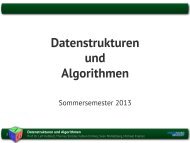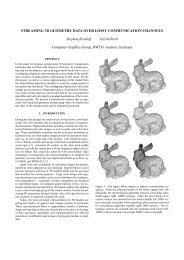Structure Preserving CAD Model Repair - OpenFlipper
Structure Preserving CAD Model Repair - OpenFlipper
Structure Preserving CAD Model Repair - OpenFlipper
You also want an ePaper? Increase the reach of your titles
YUMPU automatically turns print PDFs into web optimized ePapers that Google loves.
Stephan Bischoff & Leif Kobbelt / <strong>Structure</strong> <strong>Preserving</strong> <strong>CAD</strong> <strong>Model</strong> <strong>Repair</strong><br />
non-critical 6-neighbors w of v. Here, δ smooth is a special<br />
value to tell the reconstruction algorithm that w + δ smooth d<br />
corresponds to a fill-in and that the corresponding vertices<br />
should be smoothed in a postprocessing phase.<br />
Figure 4: Erosion. To the left we see the set C 2 of critical<br />
vertices that fills in a gap between two patches. The green<br />
vertices are removed by a topology-preserving erosion operation.<br />
The red vertices cannot be removed without disconnecting<br />
the two patches. Right: Each remaining (blue) vertex<br />
is replaced by cuts pointing into the vertex. All cuts now<br />
form the interface that is extracted in the later stages of the<br />
algorithm to close the gaps by surface patches.<br />
critical cell critical vertex ∈ C ′<br />
removed cuts<br />
additional cuts<br />
Figure 5: Example configurations (cont.) The topologypreserving<br />
erosion operation (Section 3.3) shrinks C γ to a<br />
smaller set C ′ which is surrounded by additional cuts. Grid<br />
cells that are adjacent to a critical vertex ∈ C ′ or that are<br />
intersected by multiple patches are marked as critical (Section<br />
3.4).<br />
3.4. Clipping<br />
In this stage we clip M against a set of critical grid cells D<br />
into an inside and an outside component such that the inside<br />
component contains all the artifacts of the model. The inside<br />
component is then discarded and replaced by a well-behaved<br />
reconstruction as described in Section 3.5.<br />
First, we need to determine the set of critical grid cells D.<br />
As D should cover all artifacts of M, i.e. all intersections<br />
and all gaps, we set a grid cell to critical,<br />
• if it contains two or more patches of M (intersection) or<br />
• if one of its incident vertices is critical (gap)<br />
Figure 5 shows some example configurations of M and their<br />
corresponding critical grid cells. In the following, we will<br />
denote a grid face as critical, if it shares an un-critical and a<br />
critical cell. A grid edge is called critical, if it is incident to<br />
a critical face.<br />
The basic idea is to split all triangles of M along the critical<br />
faces into sub-triangles such that each sub-triangle either<br />
lies completely inside or completely outside the critical region<br />
D. We then simply discard those triangles that lie completely<br />
inside.<br />
Although the mathematics of intersecting planar faces is<br />
straightforward, the actual implementation of an efficient<br />
and numerically robust clipping algorithm is a hard problem.<br />
In the following we will present a new algorithm that is<br />
specifically tailored to our setup.<br />
• At all times during the run of the algorithm the meshes<br />
stay triangle meshes. We do not have to cope with general<br />
polygons of arbitrary valence, containing holes, etc.<br />
In fact, we modify the meshes using only the Euleroperations<br />
split-1-to-3 and split-2-to-4 (edge-split) which<br />
are provided as elementary operations by most mesh libraries.<br />
• By using a mixed fixed-point/adaptive-precision representation<br />
for the vertex locations, we achieve considerable<br />
speedups without sacrifying robustness or accuracy.<br />
The clipping proceeds in three phases which are illustrated<br />
in Figure 6. In phase I we intersect the critical edges<br />
and the model faces and insert the intersection points into<br />
the model using 1-to-3 or 2-to-4 splits. In phase II we intersect<br />
the critical faces and the model edges, again inserting<br />
the intersection points using 2-to-4 splits. This process automatically<br />
produces the edges that result from intersecting<br />
a model triangle with all critical grid faces. Thus each triangle<br />
now either lies completely inside or completely outside<br />
the critical cells. In phase III we then simply discard those<br />
triangles whose center of gravity lies in a critical cell.<br />
To effectively enumerate the critical edges and critical<br />
faces, we use the recursive octree traversal technique proposed<br />
by Ju et al [JLSW02]. However, to speed up the algorithm,<br />
before descending into an octree cell, we first test<br />
c○ The Eurographics Association and Blackwell Publishing 2005.




